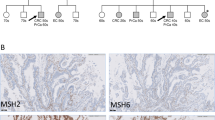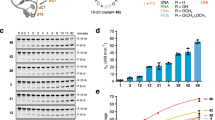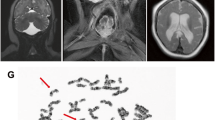Abstract
Affected and unaffected members of a Caucasian family with Werner syndrome were analyzed for mutations in the recently described Werner syndrome (WRN) gene and for their relevance to phenotypic expression of chromosomal instability and x-ray hypersensitivity. Two distinct molecular alterations were documented in the family. Analysis of the genomic DNA revealed a single-base exchange from A to T at an intron-exon boundary in the otherwise strongly conserved 5′ donor splice site. Consequently, exon 30 is spliced together with the intron. The ensuing structure could be confirmed by the presence and calculated size of the resulting RNA fragments. The patients, all compound heterozygotes, had a 1-bp deletion in the first third of the coding sequence in the other allele. The genotypes of the family members for these mutations were determined and consequences for the cellular phenotype of the otherwise unaffected heterozygotes are documented.
Similar content being viewed by others
Log in or create a free account to read this content
Gain free access to this article, as well as selected content from this journal and more on nature.com
or
References
Werner CWO: Katarakte in Verbindung mit Hautveränderungen, Diss. Kiel, 1904.
Goto M, Tanimoto K, Horiuchi Y, Sasazuki T: Family analysis of Werner syndrome: A survey of 42 Japanese families with a review of literature. Clin Genet 1981;19:8–15.
Epstein CJ, Martin GM, Schultz AL, Motulsky AG: Werner’s syndrome. A review of its symptomatology, natural history, pathologic features, genetics, and relationship to the natural aging process. Medicine 1966;45:177–221.
Goto M, Takeuchi F, Miyamoto K: Clinical, demographic, and genetic aspects of the Werner syndrome in Japan. Adv Exp Med Biol 1985;190:245–261.
Salk D: Werner syndrome: A review of recent research with an analysis of connective tissue metabolism, growth control of cultured cells, and chromosomal aberrations. Hum Genet 1982;62:1–15.
Martin GM, Sprague CA, Epstein CJ: Replicative life-span of cultivated human cells. Effect of donor age, tissue, genotype. Lab Invest 1970; 23:86–92.
Salk D, Bryant K, Hoehn H, Martin GM: Systematic growth studies, cocultivation, and cell hybridisation studies of Werner syndrome cultured skin fibroblasts. Hum Genet 1981;58: 310–316.
Poot M, Hoehn H, Rünger T, Martin GM: Impaired S-phase transit of Werner syndrome cells expressed in lymphoblastoid cell lines. Exp Cell Res 1992;202:267–273.
Weirich-Schwaiger H, Weirich HG, Gruber B, Schweiger M, Hirsch-Kauffmann M: Correlation between senescence and DNA repair in cells from young and old individuals and in premature aging syndromes. Mutat Res 1994; 316:37–48.
Weirich HG, Weirich-Schwaiger H, Kofler K, Sidoroff A, Fritsch P, Schachtschabel DO, Schweiger M, Hirsch-Kauffmann M: Werner syndrome: Studies in an affected family reveal a cellular phenotype of unaffected siblings. Mech Ageing Dev 1996;88:1–15.
Yu CE, Oshima J, Fu YW, Hisama F, Wijsman EM, Alisch R, Matthews S, Nakura J, Miki T, Ouais S, Martin GM, Mulligan J, Schellenberg GD: Positional cloning of the Werner’s syndrome gene. Science 1996;272:258–262.
Oshima J, Yu CE, Piussan C, Klein G, Jabkowski J, Balci S, Miki T, Nakura J, Ogihara T, Ells J, Smith M de AC, Melaragno MI, Fraccaro M, Scappaticci S, Matthews J, Ouais S, Jarzebowicz A, Schellenberg GD, Martin GM: Homozygous and compound heterozygous mutations at the Werner syndrome locus. Hum Mol Genet 1996;5:1909–1913.
Goto M, Imamura O, Kuromitsu J, Matsumoto T, Yamabe Y, Tokutake Y, Suzuki N, Mason B, Drayna D, Sugawara M, Sugimoto M, Furuichi Y: Analysis of helicase gene mutations in Japanese Werner’s syndrome patients. Hum Genet 1997;99:191–193.
Yu CE, Oshima J, Wijsman EM, Nakura J, Miki T, Piussan C, Matthews S, Fu YH, Martin GM, Schellenberg GD and the Werner’s Syndrome Collaborative Group: Mutations in the consensus helicase domains of the Werner syndrome gene. Am J Hum Genet 1997;60:330–341.
Verma RS, Babu A: Human Chromosomes. Manual of Basic Techniques, New York, Pergamon Press, 1989.
Countryman PL, Heddle JA: The production of micronuclei from chromosome aberrations on irradiated cultures of human lymphocytes. Mutat Res 1976;41:321–332.
Sambrook J, Fritsch EF, Maniatis T: Molecular Cloning, A Laboratory Manual, ed 2, 1989.
Stefanini M, Scappaticci S, Lagomarsini P, Borroni G, Berardesca E, Nuzzo F: Chromosome instability in lymphocytes from patients with Werner’s syndrome is not associated with DNA repair defects. Mutat Res 1979;219:179–185.
Saito H, Moses RE: Immortalization of Werner syndrome and progeria fibroblasts. Exp Cell Res 1991;192:373–379.
Fujiwara Y, Higashikawa T, Tatsumi M: A retarded rate of DNA replication and normal level of DNA repair in Werner’s syndrome fibroblast cultures. J Cell Physiol 1977;92:365–374.
Higashikawa T, Fujiwara Y: Normal level of unscheduled DNA synthesis in Werner’s syndrome fibroblasts in culture. Exp Cell Res 1978;113:438–441.
Acknowledgements
We are indebted to the Thyssen-Stiftung and to the ‘Fonds der Chemischen Industrie’ for financial support. The work was further supported by the ‘Deutsche Forschungsgemeinschaft’ SCHW 532/2-1 and by the ‘Österreichische Nationalbank, Jubiläumsfonds 4842’. Determination of hyaluronate in urine was performed by Dr. H. Greiling, Aachen, Germany. We are also grateful to Dr. D.H. Kauffmann Jockl, New York, N.Y., for critical reading and improving the manuscript.
Author information
Authors and Affiliations
Corresponding author
Rights and permissions
About this article
Cite this article
Meißlitzer, C., Ruppitsch, W., Weirich-Schwaiger, H. et al. Werner Syndrome: Characterization of Mutations in the WRN Gene in an Affected Family. Eur J Hum Genet 5, 364–370 (1997). https://doi.org/10.1007/BF03405944
Received:
Revised:
Accepted:
Issue date:
DOI: https://doi.org/10.1007/BF03405944



